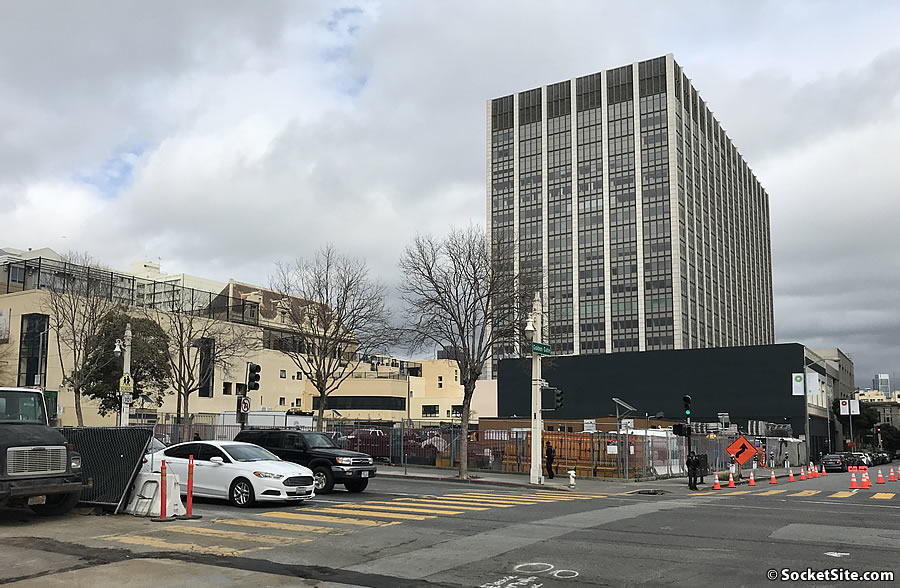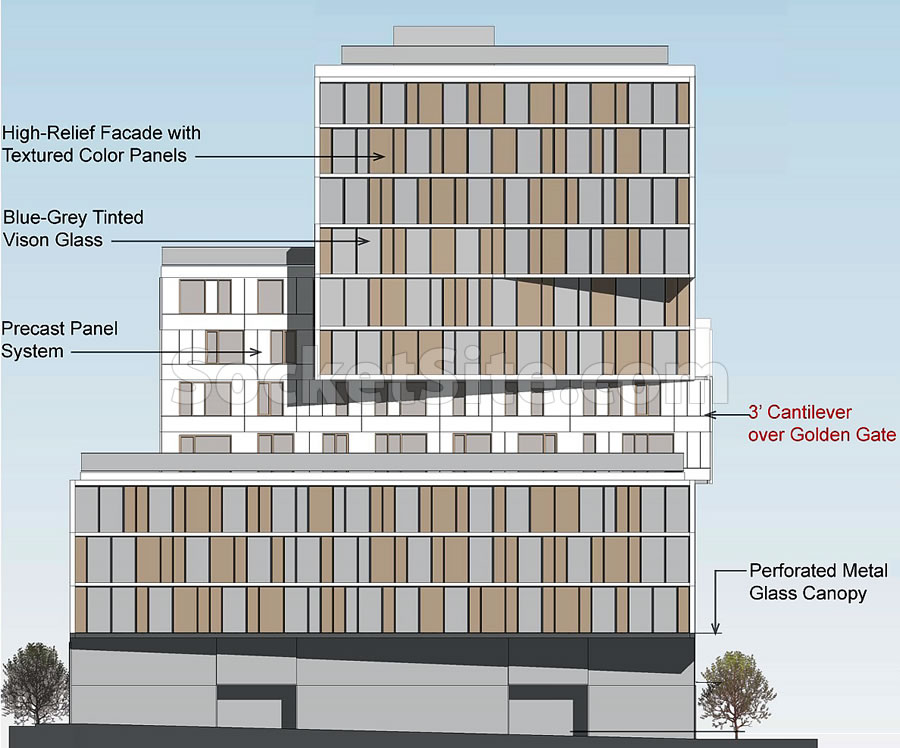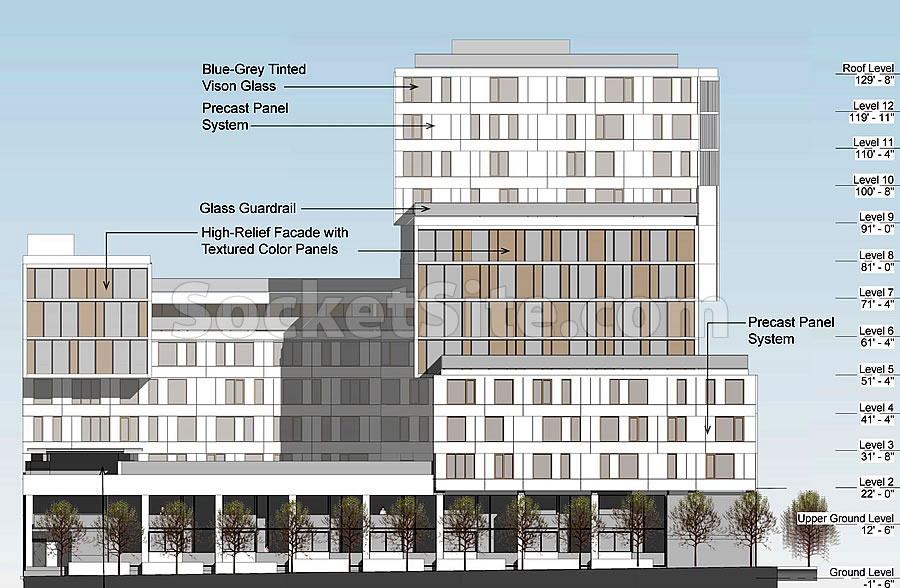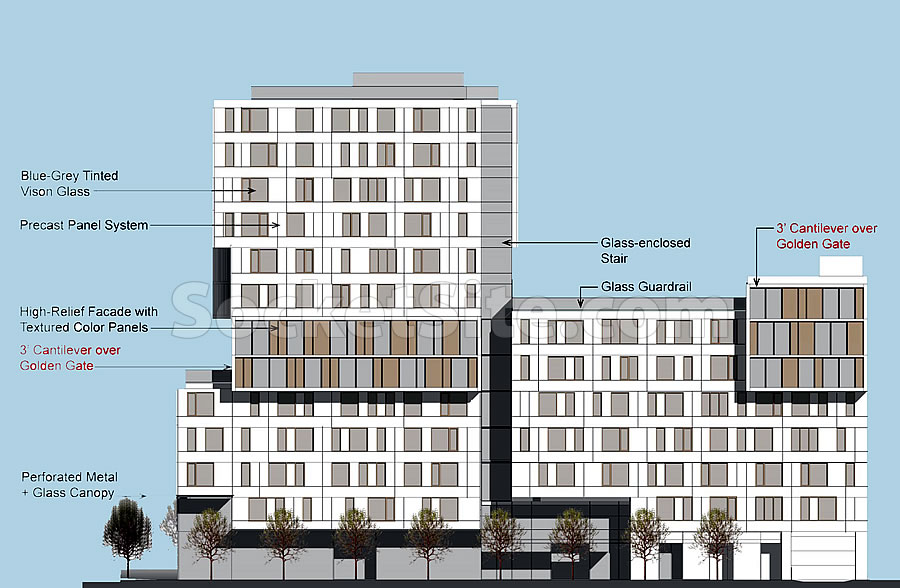While the former McDonald’s site on the northeast corner of Van Ness and Golden Gate Avenue is likely to remain a construction staging area for the Van Ness Bus Rapid Transit (BRT) project through mid-2020 (versus late 2019 as originally projected), the plans for a 168-unit apartment building to rise up to 13 stories in height upon the 600 Van Ness Avenue parcel are progressing, as newly rendered below.
While the proposed building would reach a height of 130 feet on the corner, it would step down to 8 stories and 81 feet along Golden Gate Avenue, down to five stories and 51 feet in height at the corner of Van Ness and Elm Street, and down to 2 stories and 22 feet in height along Elm.
In addition to the 168 apartments, the plans now include a 103-car basement garage with its entrance on Golden Gate, 6,200 square feet of ground floor retail fronting Golden Gate and Van Ness, and a total of 26 new street trees.
Assuming the project is approved, the development is financed, and the ground is broken, the building could be ready for occupancy in 2022 based on a projected 24-month construction period.
And of course, there’s another proposed development directly across the street as well. We’ll keep you posted and plugged-in.




Love that projects are popping up on Van Ness. Would love to see Van Ness become a new corridor of restaurants, retail and plenty of housing. Am anxious to see how the BRT project revitalizes Van Ness as well.
or how BRT destoys it.
And if we sacked up and had more commitment to vision, we could have a MUNI subway line up Van Ness from the Mission (or Balboa Park if the J was integrated) to the Marina.
I expect these BRT lines running in dedicated rights of way (mainly in the medians) eventually will be converted to LRV lines and, with priority traffic lights at intersections, they could run pretty fast. On corridors like Van Ness it makes sense to have surface LRV with stops every 2 blocks vs subways with stops much less frequently.
The LRV T-line has had dedicated right-of-way for 15 years, the City has never come close to making the traffic light signal priority work….
Revitalizes? I suspect the BRT will be a money pit as Uber etc puts bus lines out of business
Buses will travel much faster than ubers along van ness so it would be pretty competitive for this line
Buses will definitely travel faster, but I don’t see “much” faster. The trick with bus speed is that as you get more successful, and are picking up more people, the same bus spends more time loading and unloading.
Dedicated bus lanes will be key when we swap to driverless automated vehicles though. Dramatically lowering labor costs by eliminating drivers will allow MUNI to buy more equipment and double bus frequency.
I might add that the bus drivers actually know where they are going as well! I for one would much rather rely on a regular bus route that follows a schedule so I know when to catch it, where it will go, and about what time it will get there then running all over the place to catch a double parked car that follows a faulty algorithm to my destination. It’s much more efficient and better for the environment.
Not everyone is an entitled, little Millennial punk with a weak beard. Not yet, anyway. Some of us don’t need someone else to drive us to daycare, err, work…
Uber & Lyft are vastly more expensive than MUNI. There will always be a market for an affordable option.
Uber is not going to put BRT out of business. There are many, many people like me who prefer Muni and other public transportation options to Uber most of the time for the simple, irreducible reason that Muni is cheaper – a lot cheaper.
On the line I use most often, the Fulton 5 and 5R, the service and buses themselves have improved dramatically in the last couple years. And with apps like Nextmuni and Citymapper, I rarely wait longer for a bus than for an Uber. On Van Ness, as a commenter noted above, buses will have priority over private cars in choked lanes.
What’s present is prologue: Buses and light rail are often standing-room-only. These people could use Uber and Lyft today, but don’t. Why is that? Q.E.D.
True, the Muni Rapid lines are big, big, big improvement.
Have you read the recent article (in SF Chron) about how much Uber/Lyft drivers make a month? There are so many (upwards of 40,000 in SF) that the average is about $600/month. 50-90% of the drivers quit after a short time. They will not be allowed in BRT lanes but are adding to auto congestion.
w/r/t money pits: Have you monitored the financials Uber has been posting? They are getting worse, if anything.
Once the V.C. vultures get tired of dumping billions, Uber will either fold or will raise prices to the point bus riders can no longer use them.
Uber is a bit of a financial train wreck but Lyft claims to be breaking even. The cars share services are on track to carry more passenger trips per day than MUNI by 2024. They are already at 250k per day versus MUNI’s 750k per day.
But then when everyone is taking an über, with one Millennial per car, how is anyone going to get anywhere on the public streets? Gridlock. And and environmental nightmare. Hopefully if we can get Rick Conway out of the driver’s seat, the City will crack down on über.
Of course, you dodged Brian M.’s question. No one is disputing that “car share services” carry a lot of passengers or that if their current rate of growth continues, they’ll be carrying more than MUNI.
The question is, once the venture capitalists stop allowing “car share services” to burn their money chasing “market share” and the fares start having to cover the all-in costs of the service plus a profit for the drivers, will people who would normally ride MUNI that are now taking “car share services” stop being able to afford “car share services”?
The drivers are the ones doing most of the subsidizing of Uber and Lyft. They’re working for < $4/hour, probably not consciously but just because they're bad at math.
It’s likely not a matter of being bad at math as much as cost accounting and modeling (and perhaps having been sold a different story by those in the industry to boot).
Uber’s technology is very good for chaining demand together for pooled trips. I took my first last week for 3 dollars in the suburbs mid day and it was really impressive that in my short direction there was two other riders
In lower density areas I just can’t see how buses can compete with demand response pools. Maybe eventually Uber vans will work together with public agencies in this context
Agreed that Uber pool type technology will provide a cost effective choice to public transport buses.
I know Uber is a big player in the marketplace now but I don’t see how that lasts into the future.
At some point SF, or likely some other actually progressive big city, is going to elect a smart mayor, and they will municipal-ize the City’s ride share much like the buses and streetcars were municipal-ized here 100 years ago when they were owned by the railroad barons. 🙂
Van ness is a tedious slow moving highway, underzoned buildings and no thought given to the pedestrian experience. It has major potential but not with fast surface buses and suburban height buildings. Each isolated building is just that. There is no cohesion or any vision. Hello Planning?
I am going to agree with this. Van Ness has never been a pedestrian neighborhood. You either stick to one side or the other. More restaurants, bars, shops along Polk Street, than on the other side on Franklin, with the exception of Hayes Valley.
I had to be in this neighborhood a few times for a conference and parked next to this construction site at night. It is probably the safest area since there were guards manning the site.
I imagine you didn’t notice the homeless encampment in Elm St. (hopefully to be history when this project finally moves forward). The safest place to park for now would have been the underground valet parking in Opera Plaza across the street.
I usually park in the Civic Center underground garage when court is in session. However, the conference I had was offsite which would have required a further walking distance from the Civic Center garage.
Take a look at the Van Ness Plan. The new buildings are not so much underzoned (120-130 ft heights allowed) and there is cohesion with a 40 ft street wall and setbacks above. The problem is an excessive number of not-very-distinguished supposedly historic low-rise buildings and/or facades that can’t be altered substantially. The grandest of the old auto showrooms do deserve preservation but there are other smaller structures that really don’t IMHO.
Who is the project sponsor?
The article doesn’t say who is responsible for the design of this clunky monstrosity. If the design is this mediocre even before the planners get their hands on it I fear for the outcome.
As is often the case here, the firm responsible is indicated simply by an article tag (you might say footnote). Without explicitly being stated in the article itself, it looks like it’s safe to assume that IwamotoScott is responsible for this one. And I’m surprised, to be honest. I’m going to try to withhold judgement until we see some more illustrative renderings, or a built product, and cross my fingers that I’m pleasantly surprised.
And when we run the more illustrative renderings in two weeks time, we’ll both note and tag the firm (which is our standard approach).
the federal building behind it looks almost better…..
too much rack-em-pack-em-n-stack-em buildings, with little street scale, or concepts for better urban spaces created…
planners need to learn to be more inventive…….alongside the architect on this project…
Agreed – and I’m so tired off the “random” mis-matched mullions – it was a design trend that should have died in its infancy and is quickly going to look horribly dated.
Unless I’m misreading the photos, the retail “fronting” Van Ness doesn’t actually open onto Van Ness. And the side facing Golden Gate is dead to pedestrians. This City is so stupid.
You’re misreading the renderings. There are two retail entrances on Van Ness and two on Golden Gate. Or as we wrote above, “fronting Golden Gate and Van Ness.”
I see where you wrote it, but I don’t see it in the renderings. The side that faces Van Ness seems to be a bunch of apartment patios behind white concrete blocks. I see one set of door at the far left. On the Golden Gate side, I see two large openings, which I assume are for cars. No retail doors.
The first rendering is actually the Van Ness facade, with two indented doorways. The second rendering is the Elm Street facade, with a series of residential stoops. And the third rendering is the Golden Gate facade, with three indented entrances (two retail, one lobby) and the garage entrance on the far right (note the subtle curb cut).
Thanks for explaining. I’m coming to the realization that gray in the rendering must be glass. So the Van Ness side is all glass at the street, with two entrances.
Never mind. 🙂
The side facing Golden Gate is “dead” only because the cioty allows the sidewalk there to be chronically obstructed by homeless squatters and there is not much of particular interest in the Van Ness to Polk block except a (decent) Indian/Pakistani restaurant.
Since Stars moved out years ago there has been a series of undistinguished little places across the street that quickly come and go, a bank, a language school and a Central American consulate–nothing to appeal to most people, especially when confronted with the homeless tents.
If there is attractive retail in this new project, people will be attracted, especially if they keep the sidewalk clear.
Retail on this street was always a problem because it was pretty sparse. Now we’ve put in a building that will present a blank wall on the street for 100 years.
By the time the Van Ness BRT is up and running I will be driving a Tesla to Mars…
UPDATE: Proposed Van Ness Corridor Development Closer to Reality